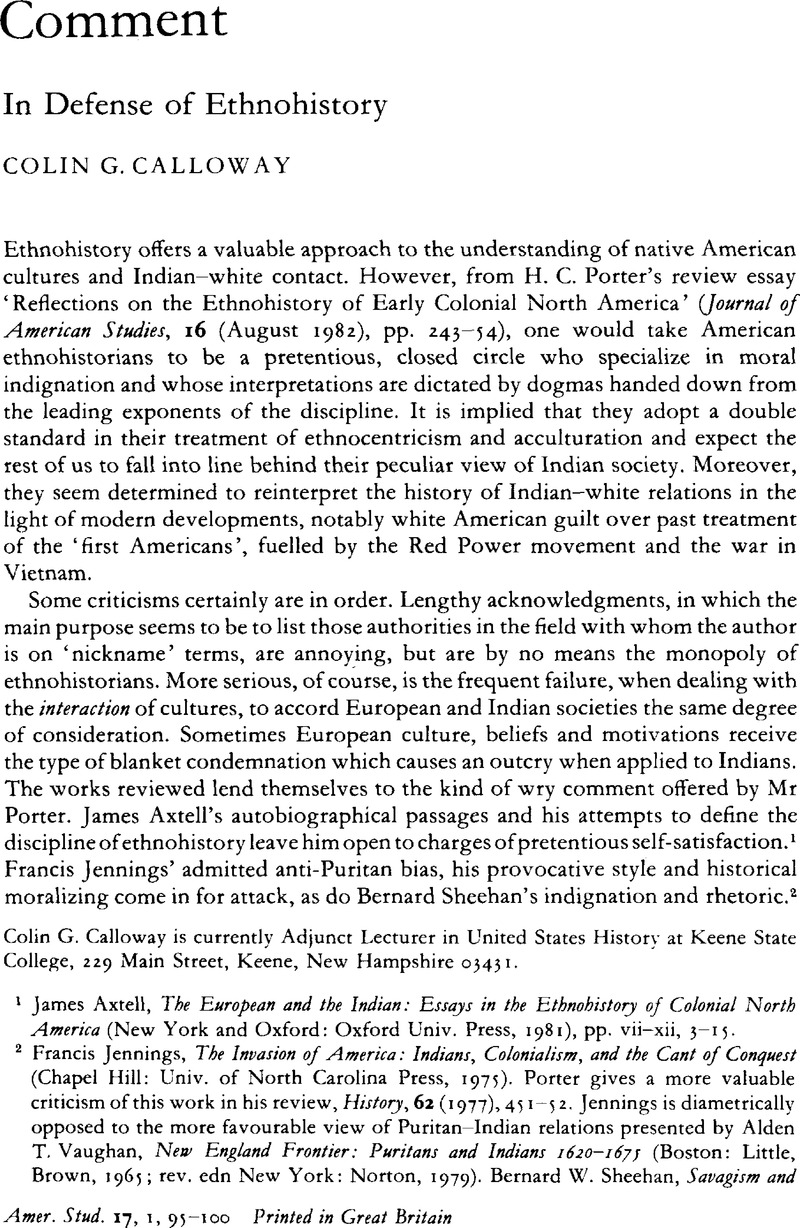No CrossRef data available.
Published online by Cambridge University Press: 16 January 2009

1 Axtell, James, The European and the Indian: Essays in the Ethnohistory of Colonial North America (New York and Oxford: Oxford Univ. Press, 1981), pp. vii–xii, 3–15Google Scholar.
2 Jennings, Francis, The Invasion of America: Indians, Colonialism, and the Cant of Conquest (Chapel Hill: Univ. of North Carolina Press, 1975)Google Scholar. Porter, gives a more valuable criticism of this work in his review, History, 62 (1977), 451–52Google Scholar. Jennings is diametrically opposed to the more favourable view of Puritan–Indian relations presented by Vaughan, Alden T., New England Frontier: Puritans and Indians 1620–1675 (Boston: Little, Brown, 1965; rev. edn New York: Norton, 1979)Google Scholar. Sheehan, Bernard W., Savagism and Civility: Indians and Englishmen in Colonial Virginia (Cambridge: Cambridge Univ. Press, 1980)Google Scholar.
3 Jacobs, Wilbur R., Dispossessing the American Indian: Indians and Whites on the Colonial Frontier (New York: Scribner's, 1972)Google Scholar. This work consists of revisions of earlier essays. In many ways more satisfactory is Jacobs, ' Diplomacy and Indian Gifts: Anglo–French Rivalry along the Ohio and Northwest Frontiers, 1748–1763 (Stanford: Stanford Univ. Press, 1950)Google Scholar, republished as Wilderness Politics and Indian Gifts: The Northern Colonial Frontier, 1748–1763 (Lincoln: Univ. of Nebraska Press, 1966)Google Scholar. Slotkin, Richard, Regeneration Through Violence: The Mythology of the American Frontier, 1600–1860 (Middletown, Conn.: Wesleyan Univ. Press, 1973)Google Scholar; Berkhofer, Robert F. Jr, The White Man's Indian: Images of the American Indian from Columbus to the Present (New York: Alfred A. Knopf, 1978)Google Scholar. Still important to the study of the white man's image and perception of the Indian is Pearce, Roy Harvey, The Savages of America: A Study of the Indian and the Idea of Civilization (Baltimore: Johns Hopkins Press, 1953)Google Scholar; paperback edn, Savagism and Civilization: A Study of the Indian and the American Mind (Baltimore: Johns Hopkins Press, 1967)Google Scholar.
4 Josephy, Alvin M., ed. in charge, The American Heritage Book of Indians (New York: American Heritage, 1961)Google Scholar. Brandon, William narrative text to this book forms the basis of his The Last Americans: The Indian in American Culture (New York: McGraw-Hill, 1974)Google Scholar; Nash, Gary B., Red, White, and Black: The Peoples of Early America (Englewood Cliffs, N.J.: Prentice-Hall, 1974)Google Scholar; Washburn, Wilcomb E., The Indian in America (New York: Harper & Row, 1975)Google Scholar.
5 Jackson, Helen Hunt, A Century of Dishonor: The Early, Crusade for Indian Reform, ed. Rolle, Andrew F. (New York: Harper & Row, 1965 (1st edn 1881))Google Scholar; Brown, Dee, Bury My Heart at Wounded Knee: An Indian History of the American West (New York: Holt, Rinehart, 1971)Google Scholar.
6 Prucha, Francis Paul, ‘Books on American Indian Policy: A Half Decade of Important Work, 1970–1975’, Journal of American History, 63 (1976–1977), pp. 658–69CrossRefGoogle Scholar; Horsman, Reginald, Expansion and American Indian Policy, 1783–1812 (East Lansing: Michigan State Univ. Press, 1967)Google Scholar; Prucha, Francis P., American Indian Policy in the Formative Years: The Indian Trade and Intercourse Acts 1790–1834 (Cambridge, Mass.: Harvard Univ. Press, 1962)Google Scholar; Sheehan, Bernard, Seeds of Extinction: Jeffersonian Philanthropy and the American Indian (Chapel Hill: Univ. of North Carolina Press, 1973)Google Scholar; Trennert, Robert A. Jr, Alternative to Extinction: Federal Indian Policy and the Beginnings of the Reservation System 1846–51 (Philadelphia: Temple Univ. Press, 1975)Google Scholar.
7 Wallace, Anthony F. C., The Death and Rebirth of the Seneca (New York: Alfred A. Knopf, 1970)Google Scholar; Trigger, Bruce G., The Children of Aataentsic: A History of the Huron People to 1660, 2 vols. (Montreal: McGill-Queens Univ. Press, 1976)Google Scholar; Gibson, Arrell M., The Chickasaws (Norman: Univ. of Oklahoma Press, 1971)Google Scholar; Jaenen, Cornelius J., Friend and Foe: Aspects of French–Amerindian Contact in the Sixteenth and Seventeenth Centuries (New York: Columbia Univ. Press, 1976)Google Scholar; Spicer, Edward H., Cycles of Conquest: The impact of Spain, Mexico, and the United States on the Indians of the Southwest, 1533–1960 (Tucson: Univ. of Arizona Press, 1962)Google Scholar; Sturtevant, William C., ed., Handbook of North American Indians, esp. 15Google Scholar: Northeast, ed. by Trigger, Bruce G. (Washington: Smithsonian Institution, 1978)Google Scholar and the forthcoming volume on Indian–white relations.
8 John, Elizabeth A. H., Storms Brewed in Other Men's Worlds: The Confrontation of Indians, Spanish, and French in the Southwest, 1540–1795 (College Station: Texas A. & M. Univ. Press, 1975), p. 4, and passimGoogle Scholar.
9 Jennings, , Invasion of America, pp. 220–25Google Scholar.
10 De Forest, John W., History of the Indians of Connecticut From the Earliest Known Period to 1850 (Hamden, Conn.: Archon Books, 1964), pp. 131–40Google Scholar.
11 Underhill's account is in Underhill, John, News from America… (London: Printed by J.D. for Peter Cole, 1638)Google Scholar; this extract is quoted in Segal, Charles M. and Stineback, David C., Puritans, Indians and Manifest Destiny (New York: G. P. Putnam's Sons, 1977), p. 136Google Scholar; Mason, John, A Brief History of the Pequot War; Especially the Memorable Taking of their Fort at Mistick in Connecticut in 1637… (Boston: S. Kneeland and T. Green, 1736), pp. 8–10Google Scholar.
12 Congressional and military commissions were set up to investigate the affair. Hoig, Stan, The Sand Creek Massacre (Norman: Univ. of Oklahoma Press, 1961), pp. 165–73Google Scholar. Extracts from the hearings which they conducted are given in the appendix.
13 For reviews of Porter, H. C., The Inconstant Savage: England and the North American Indian 1500–1660 (London: Duckworth, 1979)Google Scholar, see Axtell, James, Journal of American History, 66 (1980), 902–03CrossRefGoogle Scholar; Washburn, Wilcomb E., Journal of American Studies, 14 (1980), 157–58CrossRefGoogle Scholar; Sheehan, Bernard, William and Mary Quarterly, 3rd ser. 37 (1980), 146–50CrossRefGoogle Scholar; Vaughan, Alden T., American Historical Review, 86 (1981), 912–13CrossRefGoogle Scholar; Baird, W. David, Journal of Southern History, 46 (1980), 282–83CrossRefGoogle Scholar.